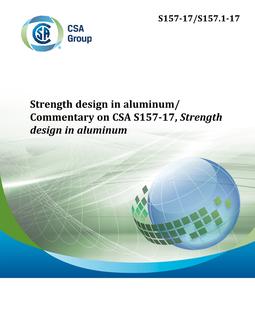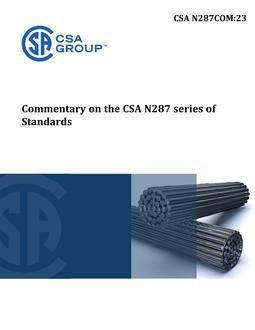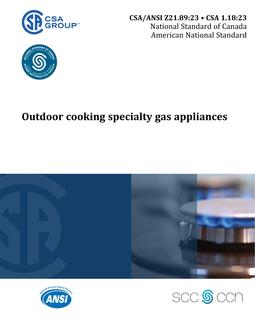
CSA S157-17/S157.1-17
- Comments Off on CSA S157-17/S157.1-17
- CSA
Click here to purchase
S157-17/S157.1-17 – Strength design in aluminum / Commentary on CSA S157-17, Strength design in aluminum
Preface
This is the fifth edition of CSA S157, Strength design in aluminum. It supersedes the previous editions published in 2005, 1983, 1969, and 1962.
This Standard is for building applications but it is written in a form that may be used for all types of aluminum load-bearing components or assemblies. Expressions for the strength of structural components are based on the concept of limit states design.
Requirements to satisfy the ultimate limit state form the core of the Standard. As a document referenced by the National Building Code of Canada, the load factors and resistance factors specified by that Code are given. However, because the design expressions predict the nominal resistance of components and connections, this Standard is useful in any field of engineering in which known applied loads are to be supported.
Serviceability limit states depend on the desired behaviour under service loads for each particular application and are not specified in this Standard. For components used in buildings, reference is made to Commentary A of the National Building Code of Canada.
CSA S157.1, Commentary on CSA S157-17, Strength design in aluminum (hereinafter referred to as the Commentary), is provided which, while not a mandatory part of the Standard, is essential to the implementation of this Standard%u2019s requirements. In this Standard, cross-references to the Commentary are identified by the prefix “C” before the clause, table, or figure number.
This edition of CSA S157 contains significant changes from the previous edition and follows, wherever possible, the same order of presentation as CSA S16, in order to facilitate the use of these two Standards:
a) A more comprehensive list of symbols is provided in Clause 3.
b) Clause 4 contains a new set of requirements on structural documents.
c) A significantly longer list of wrought aluminum products conforming to the ASTM specifications is presented in Table 1. Time-temperature limits are provided for T5 and T6 tempers and nominal strengths of aluminum filler metals are given in a new table.
d) In Clause 8, elastic analyses of structures now include second order effects and the effects of geometric imperfections. This has significant implications on the design of members subject to flexure and axial forces (Clause 14).
e) The design of built-up compression members is moved to a mandatory Annex.
f) Clause 11 presents generalized design equations for members subject to lateral-torsional buckling.
g) The extent of the heat-affected-zone (HAZ) in welded connections is redefined in Clause 15. It is now similar to the provisions of Eurocode 9 and Section 17 of CSA S6.
h) A new set of recommendations for the design of screws is included in Clause 16.7.
i) Clauses 18, 20, 21, and 22 on fabrication, erection, inspection and testing, respectively, are new clauses. They are adapted from CSA S16.
j) The specifications on the fatigue of aluminum presented in Clause 23 have been revised by incorporating the detail category and S-N curve definitions from Section 17 of CSA S6. The detail category definitions are similar to the steel definitions in Section 10 of CSA S6. The S-N curve definitions are consistent with the Aluminum Design Manual.
k) Clause 24 presents a new set of provisions for the design of composite beams (concrete slab on aluminum girders). This is an adaptation of the provisions of CSA S16 to aluminum.
CSA Group acknowledges that the development of this Standard was made possible, in part, by the financial support of the Aluminum Association of Canada, Alubec, and the Centre quebecois de recherche et de developpement de l%u2019aluminium.
———————————————————————————————————————————————————————————
S157-17 – Strength design in aluminum
Scope
1.1 Applicability
This Standard applies to limit state design, fabrication, erection, and inspection of aluminum alloy members and assemblies
a) intended to comply with building codes such as the National Building Code of Canada (NBCC); or
b) not addressed by another CSA Group standard.
When this Standard is referenced by other CSA Group standards (e.g., product standards), the requirements of this Standard apply as so specified in the referencing CSA Group standard.
Note: Annex A lists some applications to which other standards apply.
1.2 Other standards
The use of other standards for the design, fabrication, erection, and/or inspection of members or parts of aluminum structures is neither warranted nor acceptable except where specifically directed in this Standard. The substitution of other standards or criteria for design, fabrication, erection, and/or inspection is expressly prohibited unless specifically directed in this Standard.
1.3 Rational design
Where this Standard does not provide requirements for a specific situation, a rational design is to be used, based on appropriate theories, tests, analyses, or engineering experience. The design formulas provided in this Standard may be supplemented by such a rational design, provided that nominal margins (or factors) of safety are at least equal to those intended in the provisions of this Standard.
1.4 Terminology
In this Standard, “shall” is used to express a requirement, i.e., a provision that the user is obliged to satisfy in order to comply with the Standard; “should” is used to express a recommendation or that which is advised but not required; and “may” is used to express an option or that which is permissible within the limits of the Standard.
Notes accompanying clauses do not include requirements or alternative requirements; the purpose of a note accompanying a clause is to separate from the text explanatory or informative material.
Notes to tables and figures are considered part of the table or figure and may be written as requirements.
Annexes are designated normative (mandatory) or informative (non-mandatory) to define their application.
1.5 Units of measure
The expressions contained herein are dimensionally uniform, and any consistent system of units may be employed. Where dimensions are identified, SI units are used, typically newtons (N) for force, millimetres (mm) for length, and megapascals (MPa = N/mm2) for stress.
———————————————————————————————————————————————————————————
S157.1-17 – Commentary on CSA S157-17, Strength design in aluminum
Introduction
Two earlier standards for structural design in aluminum, CSA S157-1969, Structural Use of Aluminum in Buildings, and CSA S190-1968, Design of Light Gauge Aluminum Products, were based on working stress design in imperial units. These two standards were replaced in 1983 by one standard, CAN3-S157-M83, Strength Design in Aluminum, using limit states design and SI units and, in 2005, by S157-05, Strength design in aluminum.
Since the publication of the last Standard, there have been a number of developments in the philosophy of structural design in aluminum and a sufficiently large body of new knowledge from experimental and research activities to warrant revisions to the Standard in the interest of uniformity of security, improved economy, and a consistency of design philosophy throughout the procedures presented.
This Standard provides instruction for the design of aluminum load-bearing components. The procedures give the ultimate limit state, which is defined as the highest force the component or assembly will sustain prior to collapse or uncontrolled deformation.
Design treatments have been selected to provide nominal strength that have a high probability of being exceeded. The level of precision of the methods and materials used in structural engineering, as well as the scatter of test results, is such that no more than two significant figures can be justified for the coefficients in the design formulas.
Scope
As it is referenced by the National Building Code of Canada, CSA S157 includes requirements that are specific to buildings, and the load and resistance factors given are for the design of building components. However, the design procedures determine the ultimate resistances of members and connections; thus, CSA S157 has general validity and is expected to be applied to all types of load- bearing aluminum assemblies where there is no other design standard. Aircraft design, pressure vessel design, and other well-established fields have their own bodies of rules. CSA S157 is aimed at general engineering, which includes such applications as lattice towers, cranes, vehicles, and rolling stock.
Product Details
- Edition:
- 5th
- Published:
- 08/01/2017
- ISBN(s):
- 9781488307096
- Number of Pages:
- 229
- File Size:
- 1 file , 4.6 MB
- Product Code(s):
- 2425084, 2425967, 2425084, 2425084



